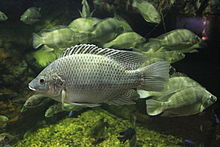Mozambique tilapia
| Mozambique tilapia | |
|---|---|
 |
|
| Scientific classification | |
| Kingdom: | Animalia |
| Phylum: | Chordata |
| Class: | Actinopterygii |
| Order: | Perciformes |
| Family: | Cichlidae |
| Subfamily: | Pseudocrenilabrinae |
| Tribe: | Tilapiini |
| Genus: | Oreochromis |
| Species: | O. mossambicus |
| Binomial name | |
|
Oreochromis mossambicus (W. K. H. Peters, 1852) |
|
| Synonyms | |
|
|
The Mozambique tilapia (Oreochromis mossambicus) is a tilapiine cichlid fish native to southern Africa. It is a popular fish for aquaculture. Dull colored, the Mozambique tilapia often lives up to a decade in its native habitats. Due to human introductions, it is now found in many tropical and subtropical habitats around the globe, where it can become an invasive species because of its robust nature. This makes it an optimal species for aquaculture because it readily adapts to new situations. It is known as black tilapia in Colombia and as blue kurper in South Africa.
The native Mozambique tilapia is laterally compressed, and has a deep body with long dorsal fins, the front part of which have spines. Native coloration is a dull greenish or yellowish, and there may be weak banding. Adults reach approximately 35 centimetres (14 in) in length and up to 1.13 kilograms (2.5 lb). Size and coloration may vary in captive and naturalized populations due to environmental and breeding pressures. It lives for up to 11 years.
It is a remarkably robust and fecund fish, readily adapting to available food sources and breeding under suboptimal conditions. It also tolerates brackish water and survives temperatures below 50 °F (10 °C) and above 100 °F (38 °C). Sustained water temperatures of 55 degrees are lethal to Mozambique tilapia.
The Mozambique tilapia is native to coastal regions and the lower reaches of rivers in southern Africa, from the Zambezi River delta to Bushman River in the eastern Cape. It is threatened in its home range by competition with the invasive Nile tilapia.
Mozambique tilapia are omnivorous. They can consume detrital material, diatoms, invertebrates, small fry and vegetation ranging from macroalgae to rooted plants. This broad diet helps the species thrive in diverse locations.
The Mozambique tilapia is an invasive species in many parts of the world, having escaped from aquaculture or been deliberately introduced to control mosquitoes. It has been nominated by the Invasive Species Specialist Group (ISSG) as one of the 100 worst invasive species in the world. It can harm native fish populations through competition for food and nesting space, as well as by directly consuming small fish. In Hawaii, striped mullet Mugil cephalus are threatened because of the introduction of this species. Mozambique tilapia may also be responsible for the decline of the desert pupfish, Cyprinodon macularius, in California's Salton Sea.
...
Wikipedia

